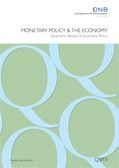Monetary Policy and the Economy Q2/17
 OeNB
OeNB
- Erschienen:
- Juni 2017
 OeNB
OeNB
Call for applications: Visiting Research Program (PDF, 53 kB) de 29.06.2017, 00:00:00
2017 marked by accelerated economic growth and declining unemployment – Economic outlook for Austria from 2017 to 2019 (June 2017) (PDF, 690 kB) Ragacs, Vondra. Austria’s economy is recovering, with both domestic and foreign demand driving the rebound. Having accelerated by 1.4% in 2016, real GDP is projected to grow by 2.2% in 2017, 1.7% in 2018 and 1.6% in 2019. These figures represent upward revisions of 0.7 and 0.2 and 0.1 percentage points, respectively, versus the OeNB’s December 2016 outlook. The unemployment rate is forecast to decline to 5.4% by 2019 from the historic peak of 6.0% seen in 2016. The inflation rate is expected to rise to 2.0% in 2017 and to reach 1.8% in both 2018 and 2019. en 29.06.2017, 00:00:00
How strong is the wealth channel of monetary policy transmission? A microeconometric evaluation for Austria (PDF, 996 kB) Albacete, Lindner. We study the magnitude and the sources of wealth effects on consumer spending in Austria by using household-level data from the Austrian Household Finance and Consumption Survey (HFCS) 2010 and 2014. Microdata allow us to investigate whether such effects exist, and if so, whether they are heterogeneous across household groups. We find evidence for a limited but statistically significant positive (long-run) relationship between wealth and consumption in Austria: a EUR 1 increase in gross/net wealth increases mean consumption by 1 cent. We also find that this effect is driven by financial assets for which the marginal propensity to consume is estimated to be around 5 cent. Furthermore, the consumption function is concave in wealth, i.e. the marginal propensity to consume out of wealth is lower for households with more wealth. However, given that in Austria wealth is concentrated in the upper tail of the wealth distribution, the decreasing marginal propensity to consume out of wealth is counterbalanced in the aggregate. Additionally, the marginal propensity to consume out of wealth increases across the consumption distribution. Regarding the various hypotheses discussed in the literature concerning the nature of the correlation between wealth and consumption, for Austria we can find support for the precautionary savings channel only. en wealth effects, consumption, housing, stock ownership D12, E21, E44, E91 29.06.2017, 00:00:00
What is the financial sector’s contribution to the Austrian economy? (PDF, 784 kB) Beer, Waschiczek. Even though its contribution to the economy has decreased since the onset of the crisis, the Austrian financial sector still accounts for about 4% of value added and about 3% of the labor force. In rendering its services, the financial sector relies on inputs from the real economy, above all legal, accounting, head office and consulting services. In Austria, the domestic financial sector is still the main funding source for the real sector, even if its share has diminished over the past decade, with the decline having been somewhat more distinct on the asset side than on the liability side. For the financial sector, financing the real sector was becoming less relevant until the crisis hit. en financial sector, intermediation, gross value added, Austria G21, G22 29.06.2017, 00:00:00
Revised competitiveness indicators for Austria reflect a comparatively stable competitiveness development of the Austrian economy over the longer horizon (PDF, 1,1 MB) Glauninger, Url. The effect of price/cost competitiveness on national exports and imports, and hence on the current account, is especially important for open economies, in particular for small open economies. In Europe the issue of short-term price/cost competitiveness gained specific prominence after the onset of the global crisis in 2008, although large external imbalances had been identified even before 2008. Across the Eurosystem, various (harmonized) indicators are used to monitor and assess national short-term price/cost competitiveness performance. In Austria, these indicators are compiled by the OeNB in cooperation with WIFO, the Austrian Institute of Economic Research. National competitiveness indicators need to be revised regularly to ensure that they adequately reflect changing country-specific trade patterns, as the reliability of these indicators crucially depends on the weights of individual trading partners. In the current release for Austria, which reflects external trade data for the period from 2010 to 2012, the basic conceptual framework was left unchanged. A comparison of the country weights for six consecutive three-year periods, starting in 1995, that underly the current release highlights the re-orientation of trade flows towards countries that joined the EU in 2004 and 2007 as well as the rising importance of China as a destination for Austrian exports. The current revision of the competitiveness indicators for Austria, as described here, indicates only small variations in Austria’s international competitiveness since 2008. Another purpose of this article is to establish which of the various price/cost competitiveness indicators best reflects our country’s short-term price competitiveness. This is done by estimating standard export and import regressions and comparing the in-sample and out-of-sample fit of models that differ only with respect to the respective real effective exchange rate index. Performance indicators show that models including real effective exchange rates deflated by unit labor costs or by producer prices create comparatively smaller estimation and forecast errors than those using the HICP/CPI. en price and cost competitiveness, effective exchange rates, manufacturing and service C43, F14, F31, F47 29.06.2017, 00:00:00